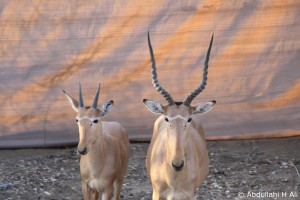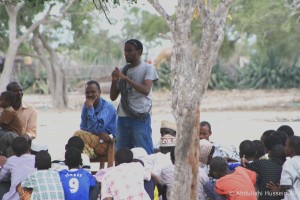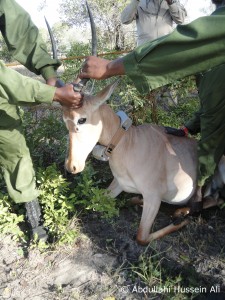Following on from Ali’s blog last week…
 In February 2012, I made a request to Kenya Wildlife Service (KWS) to fit GPS collars on 10 adult (>3 years old) female hirolas. These individuals would come from 10 different herds and the data provided by the GPS collars would enable me to assess a number of demographic parameters.
In February 2012, I made a request to Kenya Wildlife Service (KWS) to fit GPS collars on 10 adult (>3 years old) female hirolas. These individuals would come from 10 different herds and the data provided by the GPS collars would enable me to assess a number of demographic parameters.
GPS radiocollars record one GPS location every three hours throughout the year, thereby providing information of movement patterns. Each collar is also equipped with a VHF (Very High Frequency) signal which allows for monitoring and indicating mortality.
Approval from KWS came in May and by August, in time for the collaring exercise to be combined with the planned hirola translocation, the GPS collars had been manufactured (by Vectronics Aerospace, Germany) and brought to Kenya.
 But getting the collars wasn’t the only preparation needed; my and team and I were also tasked with communicating our activities to locals communities and identifying hirola herds to be targeted for collaring. We held a number of meetings informing the local communities about the collaring process and what they should expect during the collaring process (lots of visitors, low flying helicopters, capture nets, and dart guns being fired). Happily, there was a great deal of enthusiasm and interest and, as we hoped, the majority of the community members were overwhelmingly supportive, which is crucial for the future success of monitoring in the region.
But getting the collars wasn’t the only preparation needed; my and team and I were also tasked with communicating our activities to locals communities and identifying hirola herds to be targeted for collaring. We held a number of meetings informing the local communities about the collaring process and what they should expect during the collaring process (lots of visitors, low flying helicopters, capture nets, and dart guns being fired). Happily, there was a great deal of enthusiasm and interest and, as we hoped, the majority of the community members were overwhelmingly supportive, which is crucial for the future success of monitoring in the region.
Because of the elusive nature of the hirola, identifying 10 different herds for collaring in the outlying areas of Gababa was not an easy task! Droughts were also ravaging the area and this made the job even harder as it caused the groups to disperse further in search of greener pasture towards the open grasslands of the Boni Forest. Deciding on the best way of tracking the hirola was difficult and as starting point, I first trained 10 scouts on the different ways of tracking hirola, using both indigenous and scientific knowledge.
To my surprise most of the local scouts were very knowledgeable about hirola; they were able to distinguish both the footprint and faeces of hirola from that of other ungulates occurring in the same area. Using this knowledge, we began the big search – dividing the total area into five blocks and combing each block until the elusive hirola were located. In total this was a month long intensive search and we were able to identify and monitor at least seven groups before the capturing and collaring exercise began.

The GPS collars are scheduled to drop off remotely in June 2014, when they will be collected and the data accumulated. Results from this study will provide sorely-needed information on the basic ecology and natural history of the hirola. This information will form the basis of conservation and monitoring of this Critically Endangered species in its native range in North-eastern Kenya. Further radio collaring will help me construct resource selection functions to quantify the extent to which particular habitat features (distance to water, distance to settlement, percent grass cover, percent forb cover, percent tree cover, etc) are selected or avoided by hirola. This information will be used to inform future reintroduction efforts of sanctuary-bred animals.
I would like to thank to all those who contributed and supported this novel initiative. In particular, we would like to thank the Association of Zoos and Aquariums, Denver Zoo, International Foundation for Science, Mohamed Bin Zyed Species Conservation Fund, National Museums of Kenya, People’s Trust for Endangered Species, Rufford Foundation, St. Louis Zoo’s Center for Conservation in the Horn of Africa, University of Wyoming’s Haub School, and Zoological Society of London’s EDGE Programme for funding this work. Much appreciation also goes to Kenya Wildlife Service (KWS), Hirola Management Committee (HMC), National Museums of Kenya (NMK), Northern Rangelands Trust (NRT), Zoological Society of London (ZSL) and the Ishaqbini Community Conservancy (ICC) for their assistance and support during this period. We especially thank Dr. Charles Musyoki (KWS), Dr. Rajan Amin (ZSL), Cath Lawson (ZSL), Carly Waterman (ZSL) for all the logistical and academic advise provided. Special thanks go to my advisor Dr. Goheen and entire department of Zoology of the University of Wyoming for allowing me to stay in the field for one more semester to complete this crucial component of my study. Finally, I would like to extend my sincere gratitude to the scouts and community members, particularly Arawale, Gababa and Ishaqbini communities for allowing and helping me to undertake this massive initiative and their useful contribution, participation and insight have made the entire exercise interesting and successful.
To learn more about Ali’s EDGE Fellowship project on the hirola, please visit his community page.